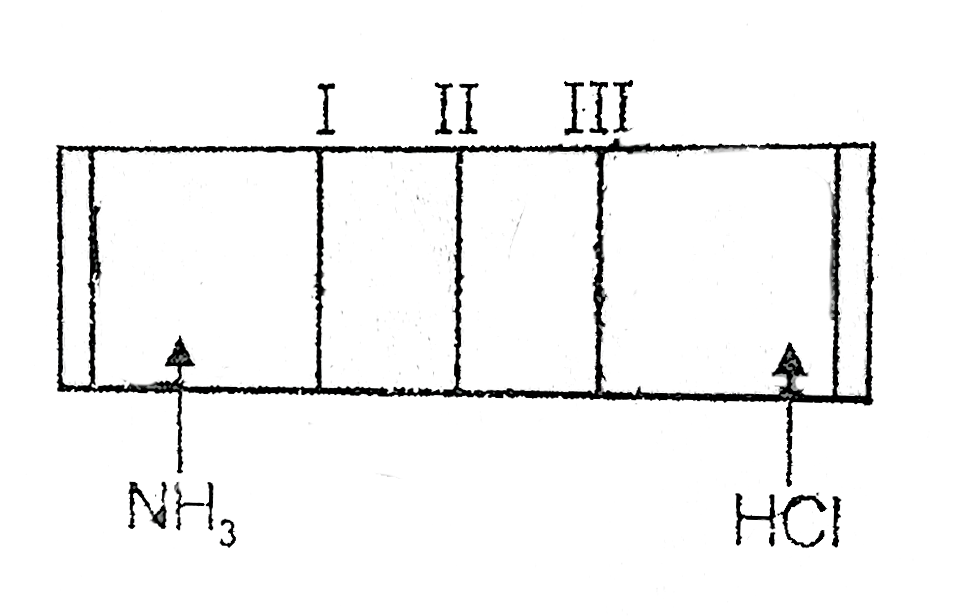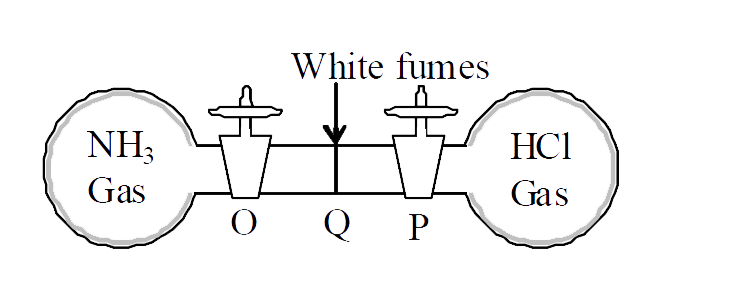The reaction between gaseous NH3 and HBr produces a white solide NH4Br. Suppose a small quantity of gaseous NH3 and gaseous HBr are introduced simultaneously into opposite ends of an open tube which is one metre long. Calculate the distance of white solid formed from the end which was used to introduce NH3
Let the distance of white solid from NH3 endx=cm
The distance of which solid from HBr end =(100−x)cm.
Rates of diffusion shall be proportional to these distances.
r1r2=x(100−x)=√MHBrMNH3
Mol. mass of HBr=1+80=81
Mol. mass of NH3=14+3=17
So, x(100−x)=√8117
or, x(100−x)=2.18
So, x=100×2.18−2.18x
So, x=100×2.183.18=68.55cm
Topper's Solved these Questions
- BOOK - OP TANDONCHAPTER - STATES OF MATTER (GASES AND LIQUIDS)EXERCISE - Illustration30videos
STATES OF MATTER (GASES AND LIQUIDS)
- BOOK - OP TANDONCHAPTER - STATES OF MATTER (GASES AND LIQUIDS)EXERCISE - Practice Problems53videos
STATES OF MATTER (GASES AND LIQUIDS)
- BOOK - OP TANDONCHAPTER - SOLUTIONS (GENERAL AND COLLIGATIVE PROPERTIES)EXERCISE - Self Assessment31videos
SOLUTIONS (GENERAL AND COLLIGATIVE PROPERTIES)
- BOOK - OP TANDONCHAPTER - STATES OF MATTER (SOLID STATE)EXERCISE - SELF ASSESSMENT Section VI3videos
STATES OF MATTER (SOLID STATE)
Similar Questions
The reaction between gaseous NH3 and HBr produces a white solide NH4Br. Suppose a small quantity of gaseous NH3 and gaseous HBr are introduced simultaneously into opposite ends of an open tube which is one metre long. Calculate the distance of white solid formed from the end which was used to introduce NH3
View SolutionThe reaction between gaseous NH3 and HBr produces the white solid NH4Br. Suppose that NH3 and HBr are introduced simultaneously into the opposite ends of an open tube that is 1 metre long. Where would you expect the white solid to form ?
View Solution
Knowledge Check
- Question 1 - Select One
Two pieces of cotton wool soaked separetely in aqueous solution of NH3 and HCl are placed at opposite ends of a close glass tube as shown in diagram

Select nearest position where white solid is formedAIBIICIIIDWhite solid does not formed - Question 2 - Select One
A bottle of dry NH3 and another bottle of dry HCl connected through a long tube are opened simultaneously at both ends of the tube. The white ring (NH4Cl) first formed will be
AAt the centre of the tubeBNear the HCl bottleCNear the ammonia bottleDThroughout the length of the tube - Question 3 - Select One
In the following diagram,container of NH3 gas and container of HCl gas, connected through a long tube, are opened simultaneously at both ends, the white NH4Cl ring first formed will be at Q point. If OP=40cm, then find OQ -
 A35 cmB23.74 cmC30 cmD31.25 cm
A35 cmB23.74 cmC30 cmD31.25 cm
At room temperature, NH3 gas at 1 atm and HCl gas at P atm are allowed to effuse through identical pinholes from oppoite ends of a glass tube of 1 metre length and uniform cross section. NH4Cl is first fomed at a distance of 60 cm from the end through whieh, HCI gas is sent in. What is the value of P?
View SolutionWhen 2.82 g of solid NH4Cl is intoroduced into a 2 L flask at 30∘C. 40 per cent of the solid NH4Cl decomposes into two gaseous products, that is NH3 and HCl. Calculate the Kc. What would happen if more amount of NH4Cl is introduced into the flask ?
View SolutionWhich laboratory results will tell whether an unknown white solid is NaOH or NH4NO3?
View SolutionA white solid A reacts with dilute H2SO4 to produce a colourless gas B and a colourless solution C. the reaction between B and acidified dichromate yields a green solution and a slightly coloured precipitate D. the substance D, when burnt in air, gives a gas E which reacts with B to yield D and a colourlesss liquid. anhydrous copper sulphate turns blue with this colourless liquid. the addition of aqueous NH3 or NaOH to C produces a precipitate that dissolves in an excess of the reagent to form a clear solution.
Q. Which of the following reactions are relevant to the action of NH3orNaOH solution on C?View SolutionA colourless mixture of two salts (A) and (B) excess is soluble in H2O. Separately (A) turns blue litmus red and (B) turns red litmus blue. (A) given white precipitate with (B), which dissolves in excess of (B) forming (C). (A) when placed in moist air gives fumes and can form dimer. (A) gives white precipitate with NH4CI and NH4OH soluble in (B).(A) also gives white precipitate with AgNO3 soluble in NH4OH.
Colourless mixture contains:View Solution

